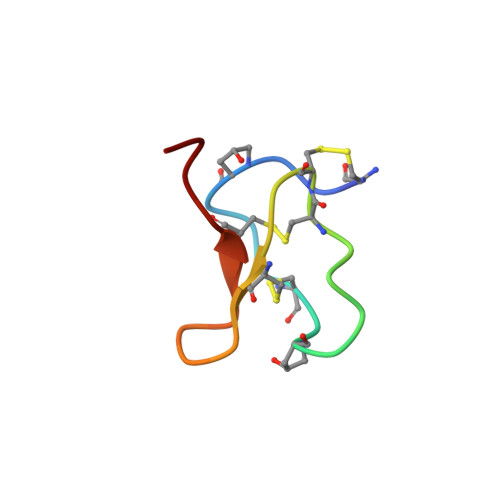Novel analgesic omega-conotoxins from the vermivorous cone snail Conus moncuri provide new insights into the evolution of conopeptides.
Sousa, S.R., McArthur, J.R., Brust, A., Bhola, R.F., Rosengren, K.J., Ragnarsson, L., Dutertre, S., Alewood, P.F., Christie, M.J., Adams, D.J., Vetter, I., Lewis, R.J.(2018) Sci Rep 8: 13397-13397
- PubMed: 30194442
- DOI: https://doi.org/10.1038/s41598-018-31245-4
- Primary Citation of Related Structures:
6CEG - PubMed Abstract:
Cone snails are a diverse group of predatory marine invertebrates that deploy remarkably complex venoms to rapidly paralyse worm, mollusc or fish prey. ω-Conotoxins are neurotoxic peptides from cone snail venoms that inhibit Ca v 2.2 voltage-gated calcium channel, demonstrating potential for pain management via intrathecal (IT) administration. Here, we isolated and characterized two novel ω-conotoxins, MoVIA and MoVIB from Conus moncuri, the first to be identified in vermivorous (worm-hunting) cone snails. MoVIA and MoVIB potently inhibited human Ca v 2.2 in fluorimetric assays and rat Ca v 2.2 in patch clamp studies, and both potently displaced radiolabeled ω-conotoxin GVIA ( 125 I-GVIA) from human SH-SY5Y cells and fish brain membranes (IC 50 2-9 pM). Intriguingly, an arginine at position 13 in MoVIA and MoVIB replaced the functionally critical tyrosine found in piscivorous ω-conotoxins. To investigate its role, we synthesized MoVIB-[R13Y] and MVIIA-[Y13R]. Interestingly, MVIIA-[Y13R] completely lost Ca v 2.2 activity and MoVIB-[R13Y] had reduced activity, indicating that Arg at position 13 was preferred in these vermivorous ω-conotoxins whereas tyrosine 13 is preferred in piscivorous ω-conotoxins. MoVIB reversed pain behavior in a rat neuropathic pain model, confirming that vermivorous cone snails are a new source of analgesic ω-conotoxins. Given vermivorous cone snails are ancestral to piscivorous species, our findings support the repurposing of defensive venom peptides in the evolution of piscivorous Conidae.
Organizational Affiliation:
IMB Centre for Pain Research, Institute for Molecular Bioscience, The University of Queensland, Brisbane, QLD, 4072, Australia.















